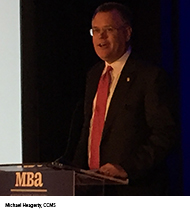
Creating a Better Borrower Experience
PHOENIX–Customer service has grown even more important to lenders and servicers because it can represent a competitive advantage, executives said here at the MBA Commercial/Multifamily Servicing and Technology Conference.
“We’ve all seen the United Airlines video of the passenger being dragged off of the plane,” said Michael Heagerty, CCMS, Principal with Newmark Realty Capital, San Francisco. “That proves that customer service still matters.”  He cited United Airline’s statement saying shortcomings in customer service and training “contributed” to the incident. “Ours is very different industry,” he said, but he noted that servicers can maintain customer satisfaction through improved client relations and quality customer service.
He cited United Airline’s statement saying shortcomings in customer service and training “contributed” to the incident. “Ours is very different industry,” he said, but he noted that servicers can maintain customer satisfaction through improved client relations and quality customer service.
First, know who your customer is, said Crystal Kalinowski, CCMS, Vice President with Bernard Financial Group, Southfield, Mich. “As mortgage bankers the production side is very dedicated to borrowers. At the same time on my [servicing] side we have a fiduciary responsibility to our lenders. You need to ensure that the borrower is following the loan documents and is doing what needs to be done. It’s a balancing act to not tip one way or the other.”
Brian Hanson, Managing Director with RealInsight/CW Capital, Bethesda, Md.–primarily a commercial mortgage-backed securities special servicer–noted that CMBS deals often involve multiple customers. “We are not a direct lender, so there are no direct borrower relationships, but I understand the importance of the borrower being satisfied so they will be repeat customers,” he said.
Hanson noted that CMBS deals’ multiple customers “are not shy about reminding us that we work for them,” he said. “For instance, [in addition to the primary servicer client and CMBS issuer,] B-piece borrowers can dictate what we do, so they are a customer, too.”
Clear communication is particularly important for CMBS deals, Hanson noted. Just as in other loans, borrowers need to know when their loan is closing, but they also need to know when their loan is accepted into a CMBS deal–and how CMBS loans differ from other capital sources the borrower may have used in the past. “I’ve had borrowers ask me, ‘Who are you? Why am I talking to you? I got my loan from Morgan Stanley’,” he said, “Sometimes they are not adequately educated on the processes required for a CMBS deal.”

Kalinowski agreed that educating borrowers on the front end is very important. “People are always in a rush, so the focus on what happens after the loan is closed can be lost at times,” she said. “That’s understandable.”
To ensure that loan closers are able to communicate well with borrowers, “we [Bernard Financial Group] are sending more closers come to this convention,” Kalinowski said. “Loan closers are the last person to talk to the borrower before it switches over to servicing. We explain to them what going to happen next. We make sure they understand what they’re signing, and what they’re doing.”
Faye Friedman, Managing Director and Head of Loan Closing and Asset Management with TH Real Estate, New York, noted that borrowers know quality customer service when they see it. “When we look at our goals, I would say are we reaching that goal by reducing the number of complaints,” she said. “Sometimes the benchmark might be check-ins or a lot of listening. You have to ask, how is this deal progressing? Is the discussion going down? You have to listen for what is being discussed.”
Kalinowski said she encourages her team to be patient with borrowers at all times. “They don’t always know what they just walked into,” she said. “It’s important to listen to your borrowers; sometimes they just need to vent. They know it might not change anything, but they feel like someone cared and it becomes a better experience going forward.”
In the end, loan servicers simply cannot give everyone all they want all the time, Hanson noted. “For instance, a borrower’s request may violate the terms of the servicing agreements,” he said. “We live by the servicing standard. What we go to great lengths to do is to educate clients, B-piece borrowers and issuers what the rules are and what our processes are that set up we will interact with everyone on the deal. They feel like we’re doing best we can to deliver for them.”
